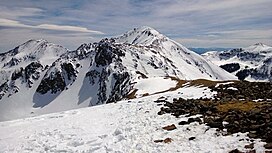| Lake Fork Peak | |
|---|---|
 North aspect, seen from Kachina Peak North aspect, seen from Kachina Peak | |
| Highest point | |
| Elevation | 12,881 ft (3,926 m) |
| Prominence | 652 ft (199 m) |
| Parent peak | Wheeler Peak |
| Isolation | 1.63 mi (2.62 km) |
| Coordinates | 36°33′01″N 105°26′43″W / 36.5503009°N 105.4452753°W / 36.5503009; -105.4452753 |
| Geography | |
  | |
| Country | United States |
| State | New Mexico |
| County | Taos |
| Protected area | Wheeler Peak Wilderness |
| Parent range | Taos Mountains Sangre de Cristo Mountains Rocky Mountains |
| Topo map | USGS Wheeler Peak |
| Climbing | |
| Easiest route | class 2 hiking |
Lake Fork Peak is a 12,881-foot-elevation (3,926 m) mountain summit in Taos County, New Mexico, United States.
Description
Lake Fork Peak is part of the Taos Mountains which are a subset of the Sangre de Cristo Mountains. It is the second-highest point in the Wheeler Peak Wilderness and ranks as the sixth-highest summit in New Mexico. The mountain is located within the Carson National Forest, 12 miles northeast of the town of Taos and 1.24 miles west-southwest of Wheeler Peak, the highest point in the state. Precipitation runoff from the mountain drains to the Rio Hondo which is a tributary the Rio Grande. Topographic relief is significant as the summit rises 2,900 feet (880 meters) above the South Fork Rio Hondo in less than one mile (1.6 km). The mountain's toponym has been officially adopted by the United States Board on Geographic Names, and the name refers to Lake Fork which is a creek that originates between this peak and Wheeler Peak. The peak has also been known as Fairview Mountain.
Climate
According to the Köppen climate classification system, Lake Fork Peak has an alpine climate with cold, snowy winters, and cool to warm summers. Due to its altitude, it receives precipitation all year, as snow in winter and as thunderstorms in summer. Climbers can expect afternoon rain, hail, and lightning from the seasonal monsoon in late July and August. This climate supports the Taos Ski Valley area immediately north of Lake Fork Peak.
See also
Gallery
-
 East aspect of Lake Fork Peak (highest point on skyline left of center)
East aspect of Lake Fork Peak (highest point on skyline left of center)
-
 Vallecito Mountain (center) and Lake Fork Peak (left)
Vallecito Mountain (center) and Lake Fork Peak (left)
-
 Taos Ski Valley with top of Lake Fork Peak visible in upper right corner behind Kachina Peak
Taos Ski Valley with top of Lake Fork Peak visible in upper right corner behind Kachina Peak
References
- ^ "Lake Fork Peak, New Mexico". Peakbagger.com. Retrieved 2024-03-22.
- Robert Julyan (2006), The Mountains of New Mexico, University of New Mexico Press, ISBN 9780826335166, p. 323.
- ^ "Lake Fork Peak - 12,881' NM". listsofjohn.com. Retrieved 2024-03-22.
- ^ "Lake Fork Peak". Geographic Names Information System. United States Geological Survey, United States Department of the Interior. Retrieved 2024-03-22.
- Robert Julyan (1996), The Place Names of New Mexico, University of New Mexico Press, ISBN 9780826351142, p. 195.
- Peel, M. C.; Finlayson, B. L.; McMahon, T. A. (2007). "Updated world map of the Köppen−Geiger climate classification". Hydrol. Earth Syst. Sci. 11. ISSN 1027-5606.
External links
- Lake Fork Peak: weather forecast
- Lake Fork Peak: Mountain-forecast.com
| Places adjacent to Lake Fork Peak | ||||||||||||||||
|---|---|---|---|---|---|---|---|---|---|---|---|---|---|---|---|---|
| ||||||||||||||||